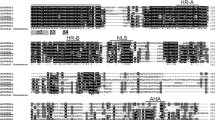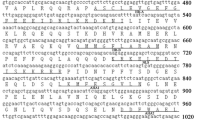Abstract
We previously cloned and analyzed the 1,893-bp promoter region (−1,915 to −23) of the tomato (Lycopersicon esculentum) Lehsp23.8 gene, whose expression is induced by treatment with high or low temperatures, heavy metal, or abscisic acid (ABA). In our present work, we examined how this expression is regulated. A comprehensive quantitative promoter deletion and base-substitution analysis was conducted under various environmental conditions. The proximal region (−565 to −23 bp) of the Lehsp23.8 promoter harbors cis-regulatory elements that conferred high levels of heat-induced expression in transgenic tobacco. Mutation of the five proximal HSEs (HSE1 to 5) of that promoter led to an absence of heat inducibility. The AT-rich regions between −255 bp and −565 bp (AT-rich1 to 4) in the promoter might serve as enhancers for such heat-induced expression. Deletion and HSE mutation analysis indicated that other cis-acting elements also function in response to low temperature, heavy metal, and ABA and that HSE1 to 5 act at least as cis-acting elements in multiple-stress responses of Lehsp23.8. These results reveal that those five proximal HSEs and AT-rich regions function interdependently in the expression of Lehsp23.8 in response to non-heat stresses. Furthermore, the putative elements CRT/DRE, AP-1, and ABRE in that promoter are not required for multiple-stress induction.







Similar content being viewed by others
Abbreviations
- ABA:
-
abscisic acid
- GUS:
-
β-glucuronidase
- HSE:
-
heat shock element
- HSF:
-
heat shock factor
- HSP:
-
heat shock protein
References
Baniwal SK, Bharti K, Chan KY, Fauth M, Ganguli A, Kotak S, Mishra SK, Nover L, Port M, Scharf KD, Tripp J, Weber C, Zielinski D, von Koskull-Döring P (2004) Heat stress response in plants: a complex game with chaperones and more than twenty heat stress transcription factors. J Biosci 29:471–487
Banzet N, Richaud C, Deveaux Y, Kazmaier M, Gagnon J, Triantaphylides C (1998) Accumulation of small heat shock proteins, including mitochondrial HSP22, induced by oxidative stress and adaptive response in tomato cells. Plant J 13:519–527
Baumann G, Raschke E, Bevan M, Schoffl F (1987) Functional analysis of sequences required for transcriptional activation of a soybean heat shock gene in transgenic tobacco plants. EMBO J 6:1161–1166
Bowler C, Fluhr R (2000) The role of calcium and activated oxygens as signals for controlling cross-tolerance. Trends Plant Sci 5:241–245
Coca MA, Almoguera C, Thomas TL, Jordano J (1996) Differential regulation of small heat-shock genes in plants: analysis of a water-stress-inducible and developmentally activated sunflower promoter. Plant Mol Biol 31(4):863–876
Czarnecka E, Ingersoll JC, Gurley WB (1992) AT-rich promoter elements of soybean heat shock gene Gmhsp17.5E bind two distinct sets of nuclear proteins in vitro. Plant Mol Biol 19(6):985–1000
Czarnecka-Verner E, Dulce-Barros M, Gurley WB (1994) Regulation of the heat shock gene expression. In: Basra AS (ed) Stress induced gene expression in plants. Harwood, Newark, pp 131–161
Doyle JJ, Doyle JL (1990) Isolation of plant DNA from fresh tissue. Focus 12:13–15
Haralampidis K, Milioni D, Rigas S, Hatzopoulos P (2002) Combinatorial interaction of cis elements specifies the expression of the Arabidopsis AtHsp90–1 gene. Plant Physiol 129:1138–1149
Heckathorn SA, Mueller JK, LaGuidice S, Zhu B, Barrett T, Blair B, Dong Y (2004) Chloroplast small heat-shock proteins protect photosynthesis during heavy metal stress. Am J Bot 91:1312–1318
Hoffmann M, Binder S (2002) Functional importance of nucleotide identities within the pea atp9 promoter sequence. J Mol Biol 320(5):943–950
Holsters M, de Waele D, Depicker A, Messens E, van Montagu M, Schell J (1978) Transfection and transformation of Agrobacterium tumefaciens. Mol Gen Genet 163:181–187
Jefferson RA, Kavanagh TA, Bevan MW (1987) GUS fusions: β-glucuronidase as a sensitive and versatile gene fusion marker in higher plants. EMBO J 6:3901–3907
Jin TE, Kim IG, Kim WS, Suh SC, Kim BD, Rhim SL (2001) Expression of chromium (VI) reductase gene of heavy metal reducing bacteria in tobacco plants. J Plant Biotechnol 3:13–17
Krishna P, Sacco M, Cherutti JF, Hill S (1995) Cold-induced accumulation of hsp90 transcripts in Brassica napus. Plant Physiol 107(3):915–923
Larkindale J, Hall JD, Knight MR, Vierling E (2005) Heat stress phenotypes of Arabidopsis mutants implicate multiple signaling pathways in the acquisition of thermotolerance. Plant Physiol 138:882–897
Li B, Liu HT, Sun DY, Zhou RG (2002) Signal transduction mechanism of plant heat shock response. J Plant Physiol Mol Biol 28(1):1–10
Liu J, Shono M (2001) Molecular cloning the gene of small heat shock protein in the mitochondria and endoplasmic reticulum of tomato. Acta Bot Sin 43(2):138–145
Liu XD, Thiele DJ (1996) Oxidative stress induced heat shock factor phosphorylation and HSF-dependent activation of yeast metallothionein gene transcription. Genes Dev 10:592–603
Lopez-Matas MA, Nunez P, Soto A, Allona I, Casado R, Collada C, Guevara MA, Aragoncillo C, Gomez L (2004) Protein cryoprotective activity of a cytosolic small heat shock protein that accumulates constitutively in chestnut stems and is up-regulated by low and high temperatures. Plant Physiol 134:1708–1717
Marrs KA, Sinibaldi RM (1997) Deletion analysis of the maize hsp82, hsp81, and hsp17.9 promoters in maize and transgenic tobacco: Contributions of individual heat shock elements and recognition by distinct protein factors during both heat shock and development. Maydica 42:211–226
Miller G, Mittler R (2006) Could heat shock transcription factors function as hydrogen peroxide sensors in plants? Ann Bot (Lond) 98:279–288
Mittler R (2006) Abiotic stress, the field environment and stress combination. Trends Plant Sci 11:15–19
Peña MM, Koch KA, Thiele DJ (1998) Dynamic regulation of copper uptake and detoxification genes in Saccharomyces cerevisiae. Mol Cell Biol 18(5):2514–2523
Pockley AG (2001) Heat shock proteins in health and disease: therapeutic targets or therapeutic agents? Exp Rev Mol Med 3(23):1–21
Raschke E, Baumann G, Schoffl F (1988) Nucleotide sequence analysis of soybean small heat shock protein genes belonging to two different multigene families. J Mol Biol 199:549–557
Rojas A, Almojuera C, Jordano J (1999) Transcriptional activation of a heat shock gene promoter in sunflower embryos: synergism between ABI3 and heat shock factors. Plant J 20(5):601–610
Sabehat A, Lurie S, Weiss D (1998) Expression of small heat-shock proteins at low temperatures. A possible role in protecting against chilling injuries. Plant Physiol 117:651–658
Sandhu JS, Webster CI, Gray JC (1998) A/T-rich sequences act as quantitative enhancers of gene expression in transgenic tobacco and potato plants. Plant Mol Biol 37(5):885–896
Saydam N, Steiner F, Georgiev O, Schaffner W (2003) Heat and heavy metal stress synergize to mediate transcriptional hyperactivation by metal-responsive transcription factor MTF-1. J Biol Chem 278(34):31879–31883
Schöffl F, Prandl R, Reindl A (1998) Regulation of the heat-shock response. Plant Physiol 117:1135–1141
Seki M, Narusaka M, Abe H, Kasuga M, Yamaguchi-Shinozaki K, Carninci P, Hayashizaki Y, Shinozaki K (2001) Monitoring the expression pattern of 1300 Arabidopsis genes under drought and cold stresses by using a full-length cDNA microarray. Plant Cell 13:61–72
Seki M, Narusaka M, Ishida J, Nanjo T, Fujita M, Oono Y, Kamiya A, Nakajima M, Enju A, Sakurai T, Satou M, Akiyama K, Taji T, Yamaguchi-Shinozaki K, Carninci P, Kawai J, Hayashizaki Y, Shinozaki K (2002) Monitoring the expression profiles of 7000 Arabidopsis genes under drought, cold and high-salinity stresses using a full-length cDNA microarray. Plant J 31(3):279–292
Singla SL, Pareek A, Grover A (1997) Yeast HSP104 homologue rice HSP110 is developmentally- and stress- regulated. Plant Sci 125(2):211–219
Sung DY, Vierling E, Guy C (2001) Comprehensive expression profile analysis of the Arabidopsis HSP70 gene family. Plant Physiol 123:789–800
Sung DY, Kaplan F, Lee KJ, Guy CL (2003) Acquired tolerance to temperature extremes. Trends Plant Sci 8:179–187
Swindell WR, Huebner M, Weber AP (2007) Transcriptional profiling of Arabidopsis heat shock proteins and transcription factors reveals extensive overlap between heat and non-heat stress response pathways. BMC Genomics 8:125. doi:10.1186/1471-2164-8-125
Thomashow MF (1999) Plant cold acclimation: Freezing tolerance genes and regulatory mechanisms. Annu Rev Plant Physiol Plant Mol Biol 50:571–599
van Leeuwen W, Ruttink T, Borst-Vrenssen AW, van der Plas LH, van der Krol AW (2001) Characterization of position-induced spatial and temporal regulation of transgene promoter activity in plants. J Exp Bot 52:949–959
Wu C (1995) Heat shock transcription factors: structure and regulation. Ann Cell Dev Biol 11:441–469
Yi SH, Sun AQ, Sun Y, Yang JY, Zhao CM, Liu J (2006) Differential regulation of Lehsp23.8 in tomato plants: analysis of a multiple stress-inducible promoter. Plant Sci 171(3):398–407
Zhao K, Kas E, Gonzalez E, Laemmli UK (1993) SAR-dependent mobilization of histone H1 by HMG-I/Y in vitro. HMG-I/Y is enriched in H1-depleted chromatin. EMBO J 12:3237–3247
Zimmermann P, Hirsch-Hoffmann M, Hennig L, Gruissem W (2004) GENEVESTIGATOR. Arabidopsis microarray database and analysis toolbox. Plant Physiol 136:2621–2632
Acknowledgements
This work was supported by the National Basic Research Program of China (Grant No. 2006CB100104) and the National Natural Science Foundation of China (Grant No. 30970233).
Author information
Authors and Affiliations
Corresponding author
Rights and permissions
About this article
Cite this article
Yi, Sy., Liu, J. Combinatorial Interactions of Two cis-Acting Elements, AT-Rich Regions and HSEs, in the Expression of Tomato Lehsp23.8 upon Heat and Non-Heat Stresses. J. Plant Biol. 52, 560–568 (2009). https://doi.org/10.1007/s12374-009-9072-4
Received:
Revised:
Accepted:
Published:
Issue Date:
DOI: https://doi.org/10.1007/s12374-009-9072-4




